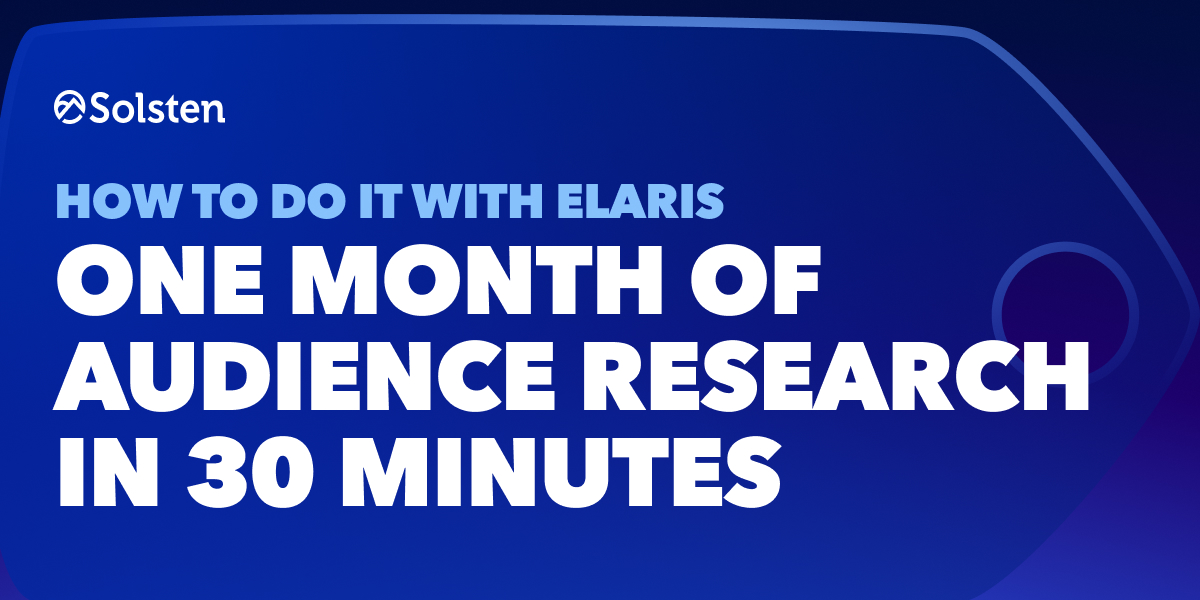Summarize this article with AI:
💬 ChatGPT
🔍 Perplexity
🤖 Claude
🔮 Google AI Mode
🧠 Elaris
Stop spending $25,000 and six weeks on research that tells you “millennials like personalized experiences.” Discover the real psychological drivers behind your audience in a single conversation.
Key Takeaways
- Replace $25,000, 6-week research with 30-minute AI conversations that deliver deeper insights
- Discover the psychological segments within any audience instead of generic demographic groups
- Get segment-specific messaging strategies that increase conversion rates through psychological alignment
- Identify underserved market opportunities that competitors miss with traditional research
- Implement insights immediately rather than waiting months for research deliverables
- Access 100,000+ audience segments with psychological profiles from millions of real people
The $25,000 Research Problem
Marketing teams across industries face the same expensive, time-consuming dilemma: understanding their audience deeply enough to create campaigns that actually convert.
What Traditional Audience Research Looks Like:
- 6-8 weeks from project kickoff to final insights
- $10,000-$50,000 for comprehensive studies
- 200-500 survey responses (if you’re lucky)
- Generic insights like “values experiences over possessions”
- Delayed implementation that misses market opportunities
The Core Problem
If you’ve been here, you know what it results in. Research that arrives too late, costs too much, and tells you what you already suspected.
But what if you could get deeper, more actionable insights about any audience in 30 minutes through a simple conversation with AI?
The 30-Minute Research Framework
Here’s exactly how to conduct comprehensive audience research using Elaris, our AI-powered audience intelligence platform. I’ll demonstrate with real data from our analysis of 141,013 travel enthusiasts, the kind of sample size that would cost traditional research firms hundreds of thousands of dollars to assemble.
Time Breakdown:
- Minutes 1-5: Initial audience definition and overview
- Minutes 6-15: Psychological segmentation discovery
- Minutes 16-25: Segment-specific messaging strategies
- Minutes 26-30: Competitive gap identification and opportunities
Required Tools:
- Elaris platform access
- Target audience definition
- List of research questions
- Implementation checklist
Live Demonstration: Understanding 141,013 Travel Enthusiasts
Step 1: The Initial Query
Research Question: “Tell me about the psychological profile of people interested in travel.”
Elaris Response: Based on 141,013 travel enthusiasts in our database, this audience breaks into six distinct psychological segments, each with fundamentally different motivations and behaviors…
Key Discovery: Instead of treating “travel enthusiasts” as one homogeneous group, we immediately discover six psychologically distinct segments. Traditional research would have stopped at “people who like to travel.”
Step 2: The Six Psychological Segments
Here’s what 30 minutes with Elaris revealed about travel psychology:
1. The Confident Socializer (33% – 46,498 people)
Psychological Profile:
- High scores: Extraversion (64th percentile), Assertiveness (75th), Humor/Fun (80th), Family (88th), Friendship (79th)
- Low scores: Risk-taking (39th), Recognition (38th)
Core Motivations: These travelers are energetic social connectors who value group experiences and family time. They want reliable, shareable experiences.
Marketing Applications:
- Social proof and influencer marketing work exceptionally well
- Group travel packages and family-friendly destinations
- Instagram-worthy experiences with low risk
- FOMO-driven limited-time group offers
2. The Visionary Achiever (7% – 10,048 people)
Psychological Profile:
- Very high scores: Grit (81st), Resilience (81st), Leadership (82nd), Purpose (81st), Assertiveness (96th)
- Low scores: Uncertainty Avoidance (30th), Power Distance (37th)
Core Motivations: High-achievers who travel for growth and purpose. They’re comfortable with uncertainty and seek meaningful, transformative experiences.
Marketing Applications:
- Premium, mission-driven travel brands
- Adventure learning and leadership retreats
- Purpose-driven tourism experiences
- Exclusive access and transformative outcomes
3. The Passionate Trendsetter (23% – 32,513 people)
Psychological Profile:
- High scores: Friendship (81st), Adventurousness (81st), Extraversion (51st)
- Low scores: Grit (39th), Making a Difference (31st)
Core Motivations: Emotional, status-conscious travelers who prioritize experiences over achievements. They’re trend-followers seeking social validation.
Marketing Applications:
- Emotional, interactive marketing campaigns
- Trendy destinations and unique experiences
- Community-driven travel offerings
- Instagram-worthy, shareable moments
4. The Creative Adventurer (6% – 8,697 people)
Psychological Profile:
- High scores: Freedom (87th), Personal Fulfillment (83rd), Openness (78th), Creativity (71st)
- Low scores: Agreeableness (22nd), Compassion (32nd)
Core Motivations: True novelty-seekers who value unique, unconventional experiences. They’re independent and resistant to typical marketing approaches.
Marketing Applications:
- Bold, unconventional marketing approaches
- Off-the-beaten-path destinations
- Creative travel formats and experiences
- Anti-mainstream positioning
5. The Skeptical Individualist (12% – 16,636 people)
Psychological Profile:
- High scores: Caution (81st), Freedom (77th), Safety (75th), Survival (70th)
- Low scores: Social Well-being (24th), Extraversion (26th), Altruism (23rd)
Core Motivations: Self-reliant travelers who prioritize safety and independence. They’re skeptical of emotional appeals and community-based marketing.
Marketing Applications:
- Direct, practical messaging with clear value
- Safety and security emphasis
- Self-directed travel options
- Concrete benefits over emotional appeals
6. The Sensitive Altruist (19% – 26,621 people)
Psychological Profile:
- Very high scores: Family (83rd), Caring (82nd), Friendship (82nd), Relationship (81st)
- High scores: Altruism (79th), Empathy (73rd), Compassion (73rd)
- Low scores: Self-esteem (23rd), Survival (27th)
Core Motivations: Empathetic travelers who value ethical, relationship-focused experiences. They respond to gentle, reassuring messaging.
Marketing Applications:
- Ethical tourism and sustainable travel
- Family-focused experiences
- Emotionally supportive messaging
- Compassionate brand values
Step 3: Messaging Strategy Development
Research Question: “How should travel brands message differently to each segment?”
Segment-Specific Messaging Strategies:
Confident Socializers (33%):
- Emphasize social experiences and group activities
- Use social proof and influencer endorsements
- Highlight family-friendly and reliable experiences
- Create FOMO through limited-time group offers
Visionary Achievers (7%):
- Focus on transformative, purpose-driven travel
- Emphasize leadership and personal growth opportunities
- Use premium positioning and exclusive access
- Highlight meaningful impact and learning outcomes
Passionate Trendsetters (23%):
- Use emotional, experience-focused messaging
- Emphasize trendy, Instagram-worthy destinations
- Create community around shared experiences
- Focus on unique, shareable moments
Creative Adventurers (6%):
- Highlight unconventional, off-the-beaten-path experiences
- Use bold, creative marketing approaches
- Emphasize freedom and unique exploration
- Avoid traditional tourism marketing tropes
Skeptical Individualists (12%):
- Use direct, practical messaging with clear value
- Emphasize safety, security, and independence
- Avoid emotional appeals or community messaging
- Focus on concrete benefits and straightforward offers
Sensitive Altruists (19%):
- Use gentle, emotionally supportive messaging
- Emphasize ethical and sustainable travel
- Highlight family and relationship-building experiences
- Focus on caring, compassionate brand values
Step 4: Competitive Gap Analysis
Research Question: “What travel segments are most underserved by current brands?”
Key Market Gaps:
- Creative Adventurers (6%) are largely ignored by mainstream travel brands
- Visionary Achievers (7%) represent a high-value, underserved premium segment
- Skeptical Individualists (12%) are put off by most travel marketing’s emotional appeals
Immediate Market Opportunities:
- A travel brand focusing exclusively on Creative Adventurers could capture an entire underserved segment
- Premium travel companies missing the Visionary Achiever segment are leaving money on the table
- Direct, practical travel offerings could win the skeptical segment that most brands alienate
Traditional Research vs. Elaris Comparison
What Traditional Research Would Have Concluded:
- “Travel enthusiasts value experiences over possessions”
- “Social media influences travel decisions”
- “Younger travelers prefer authentic experiences”
- “Family travel is important for millennials”
What Elaris Revealed in 30 Minutes:
- Six psychologically distinct segments with different motivations
- Specific messaging strategies for each segment’s psychology
- Underserved market opportunities worth millions in revenue
- Actionable insights you can implement immediately
The difference is speed, cost, depth, and actionability.
ROI Analysis
Traditional Research Approach:
| Factor | Traditional Research |
| Time | 6-8 weeks |
| Cost | $25,000-$50,000 |
| Sample Size | 200-500 responses |
| Deliverable | PowerPoint with generic insights |
| Implementation Timeline | Additional 2-4 weeks |
Elaris Approach:
| Factor | Elaris Method |
| Time | 30 minutes |
| Cost | Monthly subscription |
| Sample Size | 141,013 real psychological profiles |
| Deliverable | Immediately actionable insights |
| Implementation Timeline | Same day |
ROI Calculation:
For a company that would typically spend $35,000 on travel audience research, Elaris delivers superior insights for 99% less cost in 99% less time.
Your 30-Minute Research Template
Research Framework Questions:
Minutes 1-5: Foundation
- “What’s the psychological profile of [your audience]?”
- “How large is this audience and what are their core traits?”
Minutes 6-15: Segmentation
- “How does this audience break into psychological segments?”
- “What percentage represents each segment?”
- “What are the key differentiating traits for each segment?”
Minutes 16-25: Strategy
- “How should messaging differ for each segment?”
- “What motivates each segment to take action?”
- “What marketing approaches work best for each group?”
Minutes 26-30: Opportunities
- “Which segments are underserved by current brands?”
- “Where are the biggest market opportunities?”
- “What competitive gaps exist in this space?”
Implementation Guide
Week 1: Segment Your Current Campaigns
Action Items:
- Identify which psychological segments your current messaging targets
- Audit existing campaigns against segment preferences
- Identify the largest gaps in your current approach
Success Metrics:
- Percentage of segments currently addressed
- Gap analysis completion
- Priority segment identification
Week 2: Create Segment-Specific Messaging
Action Items:
- Develop messaging variations for your top 3 segments
- A/B test psychological insights against current approaches
- Measure engagement and conversion differences
Success Metrics:
- Message variant creation for priority segments
- A/B test launch and initial results
- Performance comparison data
Week 3: Identify Quick Wins
Action Items:
- Focus on underserved segments with high market potential
- Launch targeted campaigns for your highest-value psychological segments
- Track performance against traditional demographic targeting
Success Metrics:
- Campaign launch for underserved segments
- Performance tracking setup
- Initial conversion rate comparisons
Week 4: Scale What Works
Action Items:
- Double down on highest-performing psychological segments
- Develop comprehensive strategies for each viable segment
- Plan longer-term positioning based on psychological insights
Success Metrics:
- Resource reallocation to high-performing segments
- Long-term strategy development
- ROI measurement and optimization
Universal Application Framework
This 30-Minute Process Works for Any Audience:
E-commerce brands:
- Understand the psychology behind purchasing decisions
- Identify emotional vs. rational buyer segments
- Optimize product positioning for different motivations
SaaS companies:
- Discover what motivates software adoption across segments
- Understand decision-making psychology in business contexts
- Create onboarding flows for different user types
Consumer goods:
- Uncover the psychological drivers of brand loyalty
- Identify emotional connections to products
- Develop segment-specific product lines
B2B services:
- Identify decision-making psychology in different business segments
- Understand stakeholder motivations
- Create targeted sales approaches
The Competitive Advantage
As AI democratizes content creation and design, psychological understanding becomes the ultimate differentiator. Anyone can create professional-looking campaigns, but only brands that understand the psychology behind their audience can create campaigns that actually convert.
Why This Matters Now:
- AI Content Saturation: Generic content is becoming commoditized
- Attention Competition: Psychological relevance cuts through noise
- Consumer Sophistication: Audiences expect personalized experiences
- Marketing Efficiency: Target the right psychology, not just demographics
While your competitors are still running focus groups and analyzing demographic data (or getting generic results with ChatGPT) you can be implementing campaigns based on deep psychological insights discovered in a single conversation.
Getting Started with Elaris
Ready to Discover What Drives Your Audience?
Step-by-Step Process:
- Sign up for Elaris and access our database of psychological audience insights
- Choose your audience from 100,000+ available segments
- Ask the framework questions outlined above (ask whatever you like! Elaris knows more than you can imagine)
- Implement insights immediately in your current campaigns
For more details: Check out our step-by-step tutorial and start turning insights into action today.
What You’ll Get:
- Immediate access to psychological audience segments
- Segment-specific messaging strategies
- Competitive gap analysis
- Implementation frameworks
- ROI tracking tools
The Bottom Line
The difference between brands that thrive and brands that struggle used to be budget and team size. Now it’s understanding the psychology of the humans they’re trying to reach.
Stop guessing what your audience wants. Start knowing what drives them.
Frequently Asked Questions
How accurate is psychological segmentation compared to demographic data?
Elaris’s validation process meets or exceeds clinical psychology standards across multiple dimensions. Our reliability metrics:
- Internal consistency (Alphas): Range 0.7-0.95, mean 0.85, median 0.865
- Empirical Reliability: Range 0.74-0.96, mean 0.88, median 0.90
- These metrics exceed the minimum threshold (0.70) required for clinical applications
Learn about the science behind Elaris here
Can this work for B2B audiences?
Yes. Business decision-makers have psychological profiles that influence their professional choices. Understanding these drives more effective B2B marketing.
How often should audience research be updated?
Psychological traits are relatively stable, but market contexts change. We use Elaris on a daily basis to maintain a psychological understanding of your audience.
What if my audience spans multiple segments?
Most audiences contain multiple segments. The key is identifying the most valuable segments, underserved segments, and creating targeted approaches for each.
How does this integrate with existing marketing tools?
Psychological insights enhance existing tools by providing better targeting criteria, messaging frameworks, and campaign optimization strategies.






